What can data analytics tell us about Everton’s midfield? Everton have had a strange season, starting brightly but fading away. The rolling xG average tells the story with a sharp recent decrease in attacking productivity coupled with a large increase in the quality of chances against. 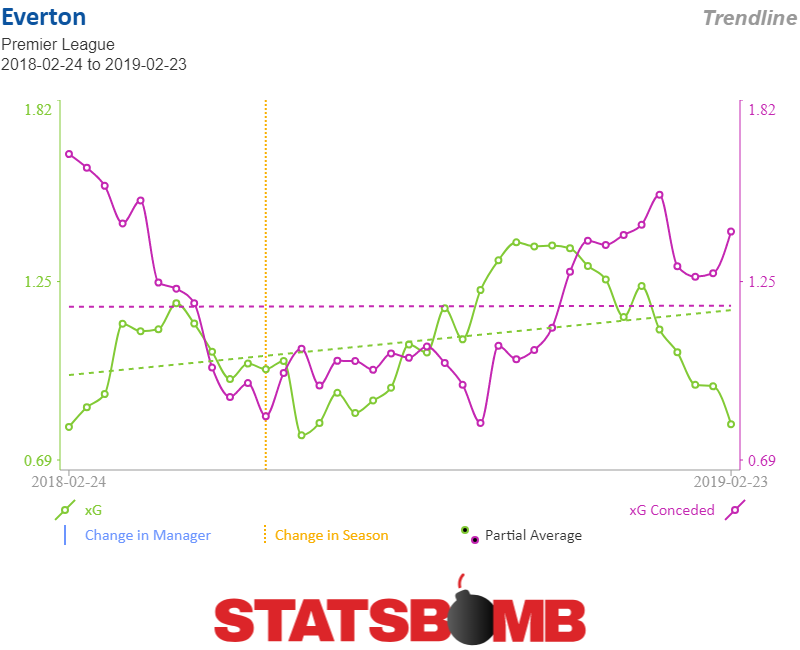 In almost every game this season Everton have lined up in a nominal 4-2-3-1 formation. The deeper two players have usually been Idrissa Gana Gueye and Andre Gomes. Ahead has been a left sided player, usually Bernard, a central player in Gylfi Sigurdsson and Theo Walcott on the right. Richarlison has often been the striker. In a 4-2-3-1 the deeper two players usually take responsibility for protecting the defence and feeding the ball to the attacking midfield and striker ahead of them. If we look at the player radars we can see that Gueye shows up very well on defensive covering stats, winning the ball back at league leading levels.
In almost every game this season Everton have lined up in a nominal 4-2-3-1 formation. The deeper two players have usually been Idrissa Gana Gueye and Andre Gomes. Ahead has been a left sided player, usually Bernard, a central player in Gylfi Sigurdsson and Theo Walcott on the right. Richarlison has often been the striker. In a 4-2-3-1 the deeper two players usually take responsibility for protecting the defence and feeding the ball to the attacking midfield and striker ahead of them. If we look at the player radars we can see that Gueye shows up very well on defensive covering stats, winning the ball back at league leading levels. 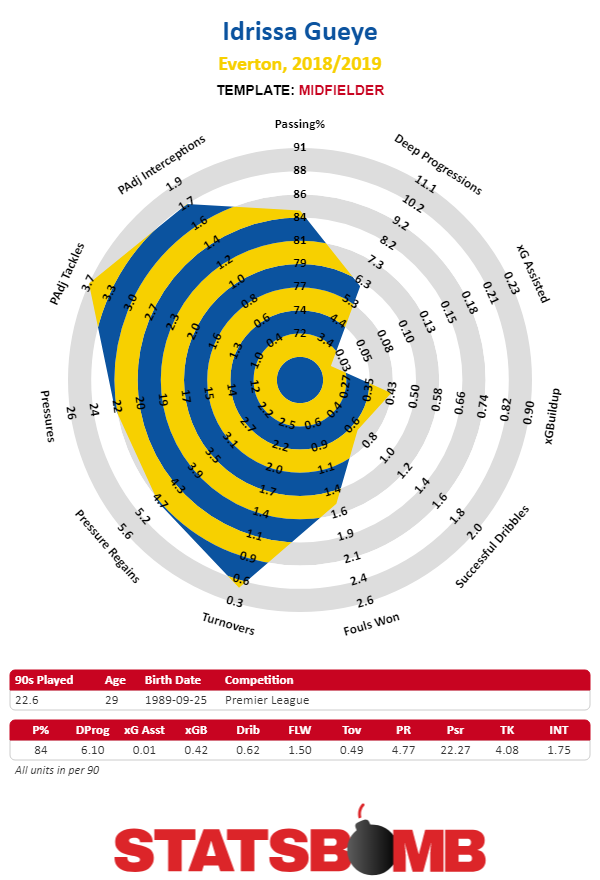 Gomes also shows signs of being able to carry the ball forwards maintaining a league average output for a central midfielder, coupled with above average dribbling stats.
Gomes also shows signs of being able to carry the ball forwards maintaining a league average output for a central midfielder, coupled with above average dribbling stats. 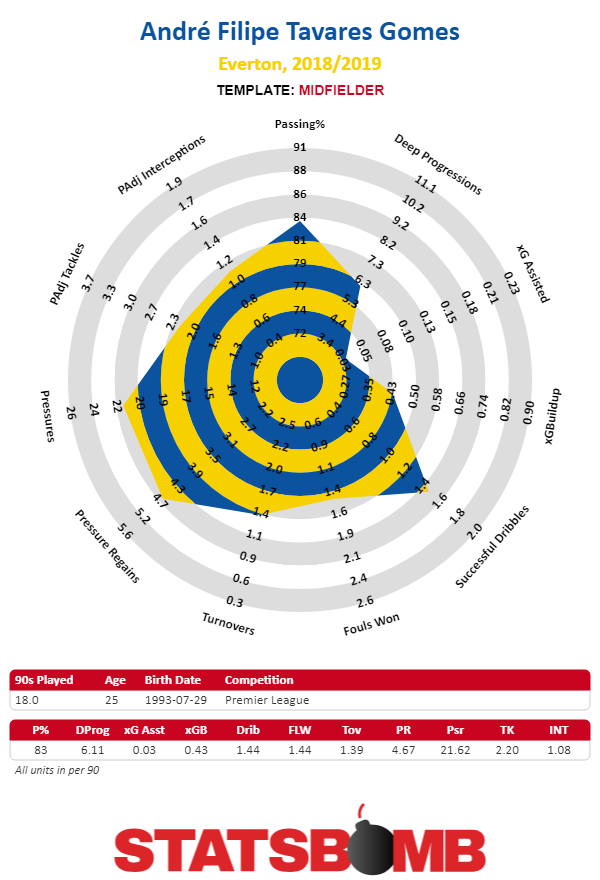 Drilling further into the Statsbomb dataset gives us more information. There are 111 midfielders who have played over 1000 minutes of first team football this season. To ensure a fair comparison we will compare Gueye and Gomes only with players described as midfielders, and Bernard, Sigurdsson and Walcott with attacking midfielders and wingers. There are 69 midfielders in our comparison group for Gueye and Gomes, for each of them we will provide a ranking from within that group of players: Open play expected assists per 90 rank: Gueye: 64/69 Gomes: 49/69 Open play passes per 90 rank: Gueye: 31/69 Gomes: 26/69 Opposition final third open play passes per 90 rank: Gueye: 44/69 Gomes: 37/69 These ranking results make sense, especially for two deep midfielders in a 4-2-3-1 formation. Everton are generating a reasonable volume of passes, but at low expected assist quality as those passes are taking place a long way from the opposition goal. Similarly ranked players, on these metrics, include Rueben Neves and Georginio Wijnaldum. The Everton pair are unlikely to be playing passes of the same quality but by way of showing where they are positioned on the pitch, and the type of passes they make, it seems reasonable. So how do the attacking midfield trio profile?
Drilling further into the Statsbomb dataset gives us more information. There are 111 midfielders who have played over 1000 minutes of first team football this season. To ensure a fair comparison we will compare Gueye and Gomes only with players described as midfielders, and Bernard, Sigurdsson and Walcott with attacking midfielders and wingers. There are 69 midfielders in our comparison group for Gueye and Gomes, for each of them we will provide a ranking from within that group of players: Open play expected assists per 90 rank: Gueye: 64/69 Gomes: 49/69 Open play passes per 90 rank: Gueye: 31/69 Gomes: 26/69 Opposition final third open play passes per 90 rank: Gueye: 44/69 Gomes: 37/69 These ranking results make sense, especially for two deep midfielders in a 4-2-3-1 formation. Everton are generating a reasonable volume of passes, but at low expected assist quality as those passes are taking place a long way from the opposition goal. Similarly ranked players, on these metrics, include Rueben Neves and Georginio Wijnaldum. The Everton pair are unlikely to be playing passes of the same quality but by way of showing where they are positioned on the pitch, and the type of passes they make, it seems reasonable. So how do the attacking midfield trio profile? 
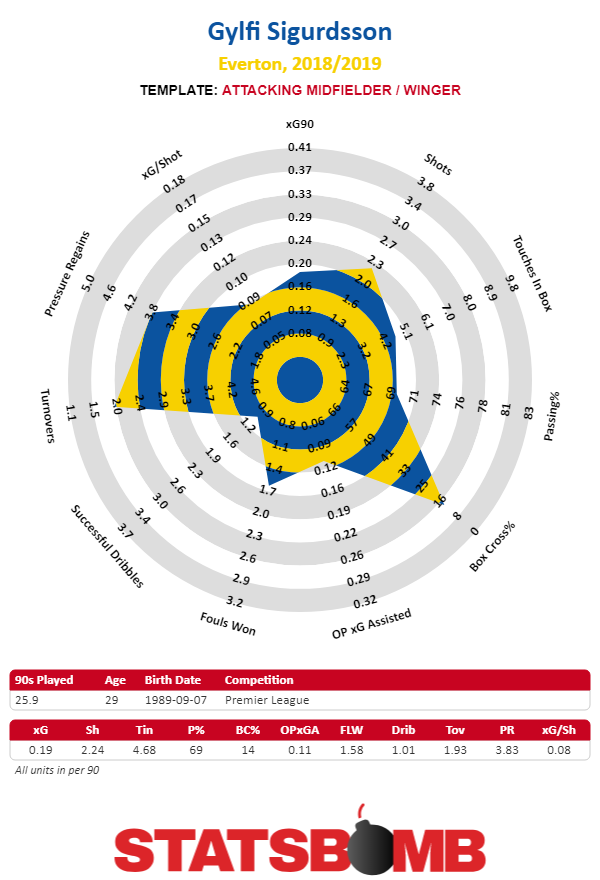
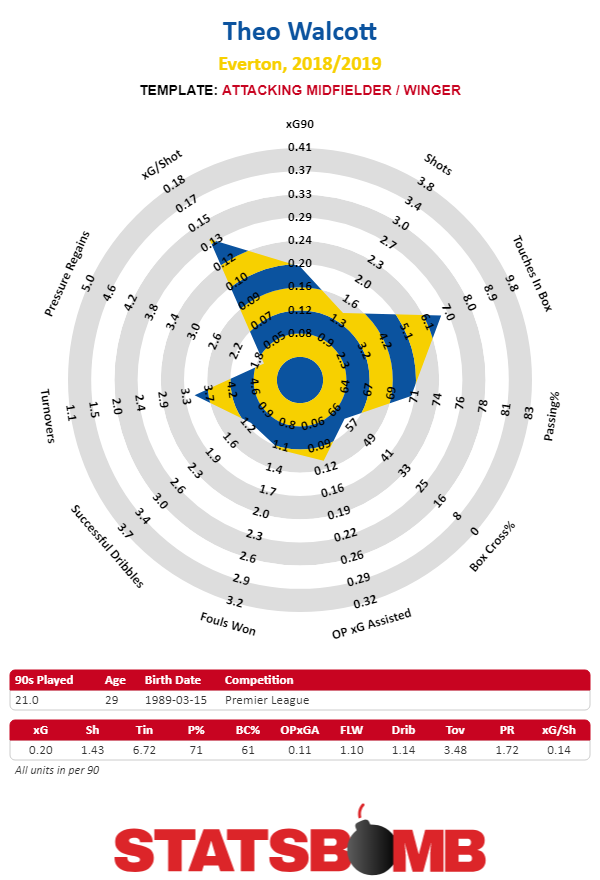 This time the comparison group contains 42 players of attacking midfielders and wingers. Open play expected assists per 90 rank: Bernard: 15/42 Sigurdsson: 25/42 Walcott: 26/42 Open play passes per 90 rank: Bernard: 24/42 Sigurdsson: 37/42 Walcott: 40/42 Opposition final third open play passes per 90 rank: Bernard 27/42 Sigurdsson 34/42 Walcott 37/42 A clear pattern emerges. Everton are extremely direct in attack, particularly Walcott and Sigurdsson, with very few interchanges between the players. When a player gets the ball they go directly for goal or try to play another player in, This is not a group concerned with exchanging passes or recycling possession. In fact we can see this by looking where they each rank among the 42 other attacking midfielders in the proportion of forward passes in the final third: Bernard: 15/42 Sigurdsson: 1/42 Walcott: 13/42 Sigurdsson is a particularly extreme example, topping the comparison chart for the proportion of passes that go forwards when in the final third but also being almost bottom for the volume. In summary he just doesn’t get involved in traditional midfield build up at all. And neither does Theo Walcott or Bernard. The question is whether this is a deliberate tactical ploy, or simply a case of incompatible players failing to link up. If we compare Everton with Wolverhampton Wanderers we see similar numbers in build up play, with Neves and Moutinho profiling similarly to Gomes and Gana. However when the 32 outfield strikers with over 1000 minutes on the pitch are sorted by expected open play assists per 90 minutes Raul Jimenez (3rd) and Diogo Jota (7th) appear a long way before Calvert-Lewin (27th), Cenk Tosun (28th) and Richarlison (31st). If neither the strikers, nor the midfielders are generating high quality chances for each other then you need to consider if the tactical approach is working. So, what exactly is Marco Silva’s tactical approach? He made his name through playing a counter-attacking 4-3-3 formation. It was said of his Olympiakos side that they were so good on the break that they were more dangerous out of possession than in. At Everton, this style of football is yet to click. Playing a 4-2-3-1 without any build up play from the three attacking midfielders, the style often more resembles a 4-2-4, with the only sustained threat coming from the left back where Lucas Digne tops the Everton attacking chart in terms of expected assists. Given the lack of threat from the front four, and the lack of interchange between them, perhaps the best option would be to move one of the attackers back into a standard midfield position and revert to a 4-3-3. The question is; whom? And if the answer is changing formation and dropping an expensive player is the club brave enough to make that decision? Can the team overcome a heavy dose of sunk cost fallacy embodied in the person of Gylfi Siggurdson and make smart, forward looking decisions? The sunk cost fallacy explains that It is painful to accept having wasted money. This pain impedes your ability to make logical decisions. Having invested so much money in Gylfi Sigurdsson it becomes almost impossible for a manager to not play him. And yet the logical change to make to Everton’s line up is moving from a 4-2-3-1 (that actually resembles a 4-2-4) to a 4-3-3. And the logical player to replace is the player currently in the number 10 role who does not contribute to the build up play. Gylfi Sigurdsson. Even without purchasing players Everton’s squad contains central midfield options of Nikola Vlasic, Kieran Dowell, Tom Davies, Morgan Schneiderlin, James McCarthy, Mo Besic, Joe WIlliams, Beni Baningime, and Callum Connolly. With Richarlison, Cenk Tosun, Dominic Calvert-Lewin, Yannick Bolasie, Henry Onyekuru, Kevin Mirallas, and Ademola Lookman fighting for a place in the front three along with Walcott and Bernard. Could Everton control games better, and play better on the break with an additional midfielder offering defensive cover and build up passing? Would a front three of, for example, Bernard, Richarlison and Lookman offer the pace and width in attack Marco Silva made his name coaching? Or could Everton change their style of play and encourage more interchange in attack, and less directness? Bernard showed at Shakhtar Donetsk he can play in a high possession 4-2-3-1, with Walcott and Sigurdsson also having had success at Arsenal and Swansea in teams known for patient build up. There are many questions for Marco Silva to find an answer to by the end of the season. He has options within his - huge - squad. First, however, he’ll have to decide to try something different, and that means accepting that the system he’s used his whole career isn’t working on the pitch at Goodison.
This time the comparison group contains 42 players of attacking midfielders and wingers. Open play expected assists per 90 rank: Bernard: 15/42 Sigurdsson: 25/42 Walcott: 26/42 Open play passes per 90 rank: Bernard: 24/42 Sigurdsson: 37/42 Walcott: 40/42 Opposition final third open play passes per 90 rank: Bernard 27/42 Sigurdsson 34/42 Walcott 37/42 A clear pattern emerges. Everton are extremely direct in attack, particularly Walcott and Sigurdsson, with very few interchanges between the players. When a player gets the ball they go directly for goal or try to play another player in, This is not a group concerned with exchanging passes or recycling possession. In fact we can see this by looking where they each rank among the 42 other attacking midfielders in the proportion of forward passes in the final third: Bernard: 15/42 Sigurdsson: 1/42 Walcott: 13/42 Sigurdsson is a particularly extreme example, topping the comparison chart for the proportion of passes that go forwards when in the final third but also being almost bottom for the volume. In summary he just doesn’t get involved in traditional midfield build up at all. And neither does Theo Walcott or Bernard. The question is whether this is a deliberate tactical ploy, or simply a case of incompatible players failing to link up. If we compare Everton with Wolverhampton Wanderers we see similar numbers in build up play, with Neves and Moutinho profiling similarly to Gomes and Gana. However when the 32 outfield strikers with over 1000 minutes on the pitch are sorted by expected open play assists per 90 minutes Raul Jimenez (3rd) and Diogo Jota (7th) appear a long way before Calvert-Lewin (27th), Cenk Tosun (28th) and Richarlison (31st). If neither the strikers, nor the midfielders are generating high quality chances for each other then you need to consider if the tactical approach is working. So, what exactly is Marco Silva’s tactical approach? He made his name through playing a counter-attacking 4-3-3 formation. It was said of his Olympiakos side that they were so good on the break that they were more dangerous out of possession than in. At Everton, this style of football is yet to click. Playing a 4-2-3-1 without any build up play from the three attacking midfielders, the style often more resembles a 4-2-4, with the only sustained threat coming from the left back where Lucas Digne tops the Everton attacking chart in terms of expected assists. Given the lack of threat from the front four, and the lack of interchange between them, perhaps the best option would be to move one of the attackers back into a standard midfield position and revert to a 4-3-3. The question is; whom? And if the answer is changing formation and dropping an expensive player is the club brave enough to make that decision? Can the team overcome a heavy dose of sunk cost fallacy embodied in the person of Gylfi Siggurdson and make smart, forward looking decisions? The sunk cost fallacy explains that It is painful to accept having wasted money. This pain impedes your ability to make logical decisions. Having invested so much money in Gylfi Sigurdsson it becomes almost impossible for a manager to not play him. And yet the logical change to make to Everton’s line up is moving from a 4-2-3-1 (that actually resembles a 4-2-4) to a 4-3-3. And the logical player to replace is the player currently in the number 10 role who does not contribute to the build up play. Gylfi Sigurdsson. Even without purchasing players Everton’s squad contains central midfield options of Nikola Vlasic, Kieran Dowell, Tom Davies, Morgan Schneiderlin, James McCarthy, Mo Besic, Joe WIlliams, Beni Baningime, and Callum Connolly. With Richarlison, Cenk Tosun, Dominic Calvert-Lewin, Yannick Bolasie, Henry Onyekuru, Kevin Mirallas, and Ademola Lookman fighting for a place in the front three along with Walcott and Bernard. Could Everton control games better, and play better on the break with an additional midfielder offering defensive cover and build up passing? Would a front three of, for example, Bernard, Richarlison and Lookman offer the pace and width in attack Marco Silva made his name coaching? Or could Everton change their style of play and encourage more interchange in attack, and less directness? Bernard showed at Shakhtar Donetsk he can play in a high possession 4-2-3-1, with Walcott and Sigurdsson also having had success at Arsenal and Swansea in teams known for patient build up. There are many questions for Marco Silva to find an answer to by the end of the season. He has options within his - huge - squad. First, however, he’ll have to decide to try something different, and that means accepting that the system he’s used his whole career isn’t working on the pitch at Goodison.
2019
Can Marco Silva Fix Everton's Attacking Struggles?
By admin
|
February 20, 2019